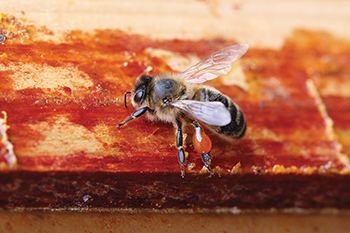
When the weather turns warm, propolis can string into fragrant tendrils like fresh-from-the-oven mozzarella cheese. When cold, it can shatter like bone china, yielding knife-sharp shards. In especially hot seasons, it can run like water down the inside of hive walls before hardening into translucent droplets that glisten like gemstones.
As fascinating as propolis is, it can test the patience of the most experienced beekeeper. It cements boxes together, glues frames to each other, sticks to fingers and tools, feeders and excluders. Worse, it makes indelible marks on clothing and bee suits. And no matter how many times you scape it away, it will be waiting for you next time you open a hive. In the beekeeper’s world of consummate stickiness, nothing outsticks propolis.
Because propolis is so messy, and because it can easily destroy the pristine look of comb honey, early breeders spent decades trying to get rid of it. They believed that developing a strain of bees that deposited little propolis would be a boon and a blessing to honey producers and simplify the tasks of beekeeping.
First Aid for Plants
You often hear that honey bees collect propolis, but that’s not quite true. Honey bees don’t collect propolis fully formed any more than they collect honey fully formed. What bees collect are the raw ingredients to make propolis, namely plant resins.
Just as nectar varies according to the local plants, so do resins. Most resins are collected from leaf buds, twigs, or the bark of trees. It may appear whitish gray, tan, a variety of browns and reds, or nearly black. The resins are made from a variety of phytochemicals that are designed to protect the plant from invasion by pathogens and predators.
The resins are produced in special cells and kept in reserve. When a plant is damaged, the resin oozes out of the cells and flows over the injury, making a bandage-like barrier that keeps out harmful bacteria and fungus. Although the specific properties vary from plant to plant, resins are alike in that they are insoluble in water and they harden when exposed to air.
Many Sources of Resin
According to the USDA Forest Service, a wide variety of plants produce resin.1 Conifer trees are famous for it, including various species of cedar, fir, juniper, larch, pine, redwood, spruce, and yew. But other trees also produce resin, such as alder, aspen, birch, chestnut, poplar, sweetgum, and willow. In addition, a surprising variety of other flowering plants produce their own resins. Examples include balsam root, caraway, creosote bush, dill, fennel, gardenia, ginseng, mayapple, morning glory, parsley, poison ivy, poison oak, quinine, rabbitbrush, sarsaparilla, sunflower, and tarweed.
Before the days of commercial chewing gum, spruce sap was a popular chew. The mechanical act of chewing along with the addition of saliva made it soft and pliable, just as the honey bee discovered. In humans, spruce resin turns the mouth red in the same way it stains woodenware and bee suits. Commercial chewing gum couldn’t come soon enough.
Collecting the Goods
A small percentage of the work force in each colony has the non-enviable task of collecting resin. Because its consistency varies with temperature, resins needs to be collected on warm days when they are soft enough to be worked. On the right kind of day, the honey bees use dance language to describe the location of a rich source. Then the select few are off to meet their challenge.
First, the worker bites off a chunk of resin. She works this with her mandibles, adding saliva for softening. Once it is pliable, the worker stores it for transport. According to entomologist Rosanna Mattingly, resins are carried in the pollen baskets. But loading resin into pollen baskets is not the same as loading pollen.2
Pollen changes sides as it is passed from the forelegs, to the mid legs, the hind legs, and finally to the baskets. Side-to-side transfer of pollen occurs as the honey bee brushes pollen from one collection spot to another, and then into the pollen press. But a load of resin stays on one side of the body and goes straight back, perhaps to limit the number of sticky transfers. From the mandibles, it is passed to the forelegs and then to the inner side of the basistarsus of the rear legs, and then into the corbiculae.
The Transformation to Propolis
Once in the hive, the worker bee needs help to offload her gooey cargo. Instead of kicking her load into an awaiting cell as she would a pollen pellet, she requires the assistance of other bees who bite ….


